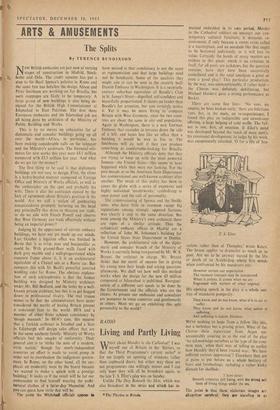ARTS & AMUSEMENTS
The Splits
By TERENCE BENDIXSON
NEW British embassies are just now at varying stages of construction in Madrid, Stock- holm and Oslo. The credit squeeze has put a stop to Sir Basil Spence's palazzo in Rome and the same fate has befallen the design Alison and Peter Smithson are working on for Brasilia, but such stoppages are likely to be temporary. A large group of new buildings is also being de- signed for the British High Commissioner at Islamabad in East Pakistan. The first three European embassies and the Islamabad job are. all being done by architects of the Ministry of Public Building and Works.
This is by no means an exhaustive list of diplomatic and consular buildings going up all over the world—Africa, in particular, has been making considerable calls on the taxpayer and the Ministry's architects. The financial,esti- mates for new works this year were £4.1 million compared with £3.5 million last year. And what do we get for the money?
The first thing to be said is that diplomatic buildings are not easy to design. First, the client is a hydra-headed monster composed of Foreign
PI Office and Ministry of Works officials, as well as the ambassador on the spot and probably his wife. There is also the confusion caused by the lack of agreement about Britain's position in the world. Are we still a nation of gunboating conquistadores promptly battering on the head any principality that dares to threaten our trade, or do we side with Enoch Powell and observe that West Germany can trade effectively without being an imperial power?
Judging by the appearance of current embassy buildings, we have not yet made up our minds. Last October a legation office was finished in Berne that is as crisp, neat and businesslike as could be. With ground-floor walls faced with dark grey marble and a well-proportioned white concrete frame above it, it is an architectural equivalent of a Chanel suit or a Rover car. But compare ..this with Sir Basil's powerful inverted wedding cake for Rome. The obvious explana- tion of such schizophrenia is that the former building was designed by Ministry architects under Mr. Bill Bedford, and the latter by a well- known private architect, but this is to get bogged down in professional rivalry. The real reason seems to be that the administrators have never considered the merits of having Britain present a' consistent face to the world. BEA and a number of other firms achieve consistency by `design manuals.' In BEA's case, this ensures that a Turkish architect in Istanbul and a Scot in Edinburgh will design sales offices that are in the same aesthetic family. Ministry of Works officials feel this stnapks of uniformity. Their general aim is to 'strike the note of a modern, virile nation,' though for newly-independent countries an effort is made to avoid pomp in order not to overshadow the indigenous govern- ment. In Rome, on the other hand, all the em- phasis on modernity went by the board because 'we wanted to make a splash with a prestige building.' It looks as if the result will be for our ambassador to find himself wearing the archi- tectural clothes of a latter-day Mussolini. And you can guess how virile that will be.
The point the Whitehall officials appear to have missed is that consistency is not the same as regimentation and that large buildings need not be bombastic. Some of the qualities they might aim at can be seen in the recently built Danish Embassy in Washington. It is a twentieth- century suburban equivalent of Boodle's Club in St. James's Street—dignified. self-confident and beautifully proportioned. It shouts no louder than Boodle's for attention, but you certainly notice it. Yet it may be more fitting' to compare Britain with West Germany, since the two coun- tries are about the same in size and population. Again in Washington, there is a new German Embassy that cascades in terraces down the side of a hill, and looks less like an office than a building' it would be nice to live in. The Smithsons will do well if they can produce something as comfortable-looking for Brasilia.
Although the Ministry officials deny that they are trying to keep up with the most powerful Joneses—the United States—this seems to have happened while they were not looking. For the past decade or so the American State Department has commissioned one well-known architect after another. The result of this policy has been to cover the globe with a series of expensive and highly individual 'masterworks,' symbolising at once power and the cult of personality.
The commissioning of Spence and the Smith- sons. who have little in common except big reputations among strongly opposed factions, was clearly a step in the same direction. But even among the Ministry's own architects there are signs of a similar attitude. Thus the cylindrical embassy offices in Madrid are a reflection of John M. Johansen's building for the United States State Department in Dublin.
However, the architectural side of the diplo- matic and consular branch of the Ministry of Works is currently being reorganised by Mr. W. S. Bryant, the architect in charge. Mr. Bryant thinks that the secret of success lies in giving his young men their heads and asking questions afterwards. We shall see how well this method works when the design for the new £3 million compound at Islamabad is published. Reorgani- sation of a different sort needs to be done by the Government and the officials who are the clients. At present our embassies and consulates are pompous in some countries and gentlemanly in others. Must we go on exhibiting this split personality to the world?






































 Previous page
Previous page